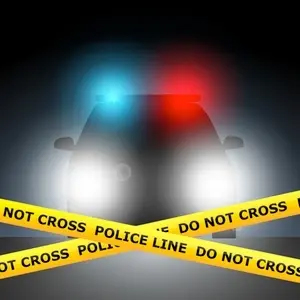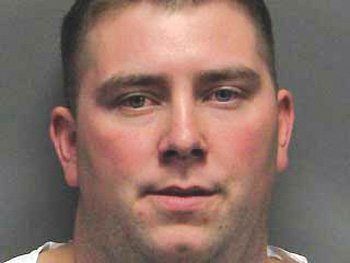
Good citizens support the local police whenever they can. Body shop owners are included in the community of those who are just as interested in getting bad guys off the streets. Sometimes the police come to the body shop looking for help. Other times, a car comes into the shop and the driver’s story – typically one involving an out-of-pocket repair – just doesn’t feel right.
Required by Law
Not only is it a good idea to work with law enforcement, but in many jurisdictions, it’s required by law.
It didn’t take legal action to get Alan Irlbeck to put aside the daily schedule for a bit to help local police.
“It’s not much of a story,” says a modest Irlbeck, owner of Irlbeck Collision Center in Manning, Iowa. In fact, he found it amusing at first. “Actually, it was fun working with the police.”
The local police had found several scattered auto parts at the scene of a hit-and-run accident.
“They came in with a bunch of broken parts in their hands from the hit-and-run,” Irlbeck says. “They asked us to take a look and to identify the parts to a specific make of vehicle.”
Almost right away, Irlbeck recognized the ear tabs off a Trailblazer. There were a few paint scrapes, too.
A second recent case involved kids “messing around, four-wheeling,” he recalls. In the process, they broke off a fog light, which Irlbeck identified as a part from a 1999 Silverado.
A Heinous Crime
It’s not always fun or easy. Sam Metz was just as horrified and sad as the rest of the Reno, Nev., community when he heard about the abduction, rape and murder of a young Santa Barbara City College student in 2008. As BodyShop Business reported two years ago, Metz was determined to help find the killer and knew he had the skills to do so thanks to his 45-plus years in the collision repair industry.

 In the early morning hours of Sunday, Jan. 20, 2008, Brianna Denison was abducted from the couch of a friend’s house she was visiting in Reno. At less than 100 pounds, she was no match for the 6-foot-tall, 200-pound kidnapper who would eventually rape and murder her.
In the early morning hours of Sunday, Jan. 20, 2008, Brianna Denison was abducted from the couch of a friend’s house she was visiting in Reno. At less than 100 pounds, she was no match for the 6-foot-tall, 200-pound kidnapper who would eventually rape and murder her.
Metz, now retired, was manager of the Bill Pearce Collision Center in Reno and is a founding president of the Nevada Collision Industry Association State Board. He reached out to Detective Dave Jenkins of the Reno Police Department and offered his help. He says Jenkins was initially skeptical that he could narrow the search for the vehicle.
“I explained to him how parts personnel determine and identify replacement components by identifying the vehicle, the function of the part, location, size, etc. Given the correct information, a replacement part can be supplied,” says Metz. “I then explained that it might be possible to reverse that process to reasonably determine a manufacturer and date range.”
Using Mitchell and CCC Pathway illustrations, Metz determined that the vehicle was a Toyota Tacoma. He confirmed his findings by viewing the illustrations and specifications on Carsdirect.com. Metz and Jenkins were then able to build a partial VIN number, and the DMV was able to provide a list of vehicle registrations.
A suspect, James Biela, was arrested a few months later and eventually tied to other rapes in the area. He was eventually convicted of five charges of kidnapping, rape and murder and sentenced to death by lethal injection. For his proactive stance against crime, Metz was one of five people who was honored at the 15th annual National Auto Body Council (NABC) Pride Awards at the Collision Industry Achievement Luncheon in 2010.
State Programs
The Alliance of Automotive Service Providers-New Jersey (AASP-NJ) started a program 15 years ago to aid the police in their investigations. It began as an effort to help improve the industry’s image.
In the very first case, they identified a vehicle and it led to an apprehension.
“We gave the police the year, make and model of the car. The officer was tickled to death,” says AASP-NJ Executive Director Charles Bryant. “We’ve been so successful with our program that it has become a full-time job.”
As word spread through the law enforcement community, it got almost too hectic to handle the requests for help. Sometimes, AASP-NJ got a half-dozen calls a week. Today, they shy away from cases that are only property damage. The program now limits investigations to severe injury or fatal accidents. They ended up developing a template with the traffic officers associations for a more efficient reporting process. Over the years, they’ve received many honors for the program.
Most other state groups don’t have a formal policy on assisting the police. Neither does the Society of Collision Repair Specialists (SCRS), according to its executive director, Aaron
Schulenburg.
David McClune, executive director of the California Autobody Association in Sacramento, says they get approached only occasionally for help. One high-profile case involved a call from the FBI, which was working a bank robbery. The getaway vehicle was damaged and they wanted a description. In another case, the California Highway Patrol (CHiP) approached a Southern California Ford dealership with pieces of a headlight and grill.
“By the angle, I could tell right away that it was an F-150,” says the service manager. “I knew within a couple of years the age, and I knew the color.”
He checked with the shop guys, who found an engineering part number and confirmed his diagnosis.
CHiP had a grocery store video of the fatal hit-and-run that they thought showed a white car. The dealership was able to ascertain that it was actually silver. This led to an identification of the vehicle right down to its VIN.
One or two weeks later, police spotted the vehicle at a bar in Alpine, Calif. They made an arrest, and the culprit is now serving time. Still, the shop wants no publicity about the case.
Justice Is Served
Sometimes, people at a shop just feel bad even though justice is served. Olmsted Township, Ohio, police knew they were looking for the driver of a dark-colored sport utility vehicle who they said struck and killed a 13-year-old boy.
A day or so later, a woman brought a maroon Sable into the Ganley Auto Body Shop in nearby Middleburg Heights. This was not to be a “who-done-it.” Dina Hanrahan, who works the front desk at Ganley, says there was something strange about the woman’s demeanor.
“I tried to get incident and insurance information from her. She was very short with me. She wanted to get out of here,” Hanrahan recalls. “She didn’t want her insurance involved. She wasn’t clear on how her car was damaged.”
Hanrahan had read about a hit-and-run in a nearby community online, and she got to thinking. In the meantime, Rick English, manager of the shop, was writing an estimate.
“I saw the damage on the right side of the car,” Hanrahan says. “I told the boss right away that it looked like it hit a person.”
Police confirmed it was the car they were looking for.
“When they came and started matching up pieces, it was a sickening feeling,” she said.
Hanrahan downplays her role. “It was just a coincidence,” she says. “It just caught my eye. And the way she acted made us suspicious.”
Assessing Damage
When a pedestrian is hit, the accident almost always takes off the side-view mirror. These glass pieces have a specific template and shape. The frame backing plate is usually plastic, and often will have a GM or Chrysler manufacturer number on it. However, even without the number, the shape and texture of the glass is specific to certain series of cars. A technician who regularly handles the mirrors can often tell at a glance where a broken part came from.
Glass shops have a template for the shape of the mirror glass. An investigator can take a broken mirror, put it on a clear overlay and go page-by-page until it’s possible to map the specific contour of the part.
In a recent case, a shop was able to tie a 2005 Dodge Caravan to a broken mirror, and the state police were able to make an arrest.
Some motorists try to fool the police and technicians. Ed Kizenberger, executive director of the Long Island Auto Body Repairman’s Association (LIABRA), recalls a shop that had a customer who claimed they hit a deer.
“The car did not present itself that way,” Kizenberger says.
For one thing, the telltale deer hair was missing. “The shop realized they were not given the whole story,” he continues. The police were notified, and they responded to the shop. Shortly thereafter, the driver was apprehended and pled to a hit-and-run charge.
Making Mistakes
The police do make mistakes. Once, police approached Bryant and asked him to help put out an APB for a specific year’s Buick Park Avenue. Bryant’s brother, Jim, looked at the parts the police had and declared, “That’s not a Buick. It’s an Olds.”
Jim Bryant knew for sure – he owned the same make and model Oldsmobile. He took the policeman out to his car and matched the header panel and grill pieces. The police checked the DMV records for an Oldsmobile…and discovered the vehicle that was involved in the hit-and-run on the third car they came across.
Kizenberger notes that some drivers have a guilty conscience about their accident. “With all the press coverage we get, they know our body shops cooperate with the police and they figure they don’t have a chance,” he says. “They turn themselves in.”
In one sad case, the police were able to identify a vehicle by glass parts and went to the woman’s house. She answered the door, saw the cop, and fell, sobbing, into his arms. She was a schoolteacher who never had been in trouble before. But she panicked, leaving a person dead. She already had the windshield on her car replaced, but the body shop had one of the wipers that had broken off the car during the accident. It matched both brand and wear perfectly to the remaining wiper. AASP-NJ got a Civil Servant Award for that catch.
But not all cases are sad.
Fun Times
Manning, Iowa, is a small town. Alan Irlbeck – and the police – know just about everyone. As the town’s tow truck driver and sole proprietor of one of only two body shops in the area, the police know him well. In the case of the hit-and-run, he was pretty sure he knew who the Trailblazer’s owner was.
“I called the owner’s uncle. He called her and told her what was up,” Irlbeck recalls. The owner got to the police before they got to her.
The Silverado case was even simpler. “They just went up to the high school,” Irlbeck chuckles. The police trolled the school parking lot until they found a vehicle with a missing light.
Even easier might have been a case in New Jersey where someone sideswiped a newly finished car parked in front of a body shop. The offending vehicle’s mirror and some paint scrapes were left behind. A woman and her son came in a couple of days later asking for a repair estimate on their car – which matched the mirror perfectly. The shop owner looked at the damage and called police.
Why would anyone bring a damaged car back to the shop where the accident occurred? The boy’s mother had chosen the shop as one of several to approach for estimates. The boy told the police he was more afraid of his mother than the cops.
Not Always Easy
It’s not always easy to help solve a case. “Sometimes you can’t identify the car or can’t find the car,” Bryant says.
When LIABRA sends out an email blast of a vehicle description to its list of shops, the descriptions range from detailed to sketchy, Kizenberger says. In addition to body shops, they include dealers and suppliers in their coverage. One never knows if a culprit will try to fix damage at home.
Several associations have been working with police for decades.
“We have networked with all the police departments on Long Island,” Kizenberger says. “Unfortunately, we still get quite a few calls.”
Like other associations, they typically limit bulletins to serious injury or fatal accidents.
Not all cases give instant gratification. The Ohio hit-and-run case still hasn’t been settled more than a year later. In fact, it took the police almost three months to arrest the woman – despite the overwhelming shop evidence.
Still, shop owners across the country point proudly to what they’ve accomplished and how their skills play a key role in nabbing criminals.
Harler is a Cleveland-based freelancer specializing in the auto, technology and environmental areas. He can be reached at [email protected].













